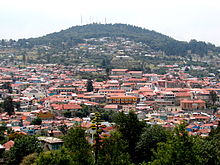1766 Real del Monte strike

The 1766 Real del Monte strike or 1766 miners' strike was a strike that occurred in the mines of Pachuca and Real del Monte when Pedro Romero de Terreros abolished the workers' party, reduced wages from 4 reales to 3 reales, and increased the workload to gain more profits.[1][2]
The miners were protesting for this reason, and they expressed their discontent to the authorities in Pachuca, but they did nothing to resolve it and told them to speak to the viceroy Joaquín Juan de Montserrat y Cruïlles. This statement led to violent conflicts on August 15, 1766.[3]
Background
The mines of Pachuca and Real del Monte

Located in the north of the Gulf of Mexico, its mines contained silver, lead, zinc, copper, and gold. The district was divided into two parts, Pachuca and Real del Monte.[4]
Due to its proximity to Mexico City, it received special interest in the search for precious metals. Thus, it became the closest mine to the capital that produced silver, facilitating its exploitation.[4]
European discovery of the mines was made on April 25, 1552 by Alonso Rodriguez de Salgado.[5][6] Between 1544 and 1555, after many attempts, Bartolome Medina found a way to extract silver. From that moment on, many workers moved there.[7]
At the beginning of the 18th century, most of the local mines were flooded, and operations were halted. The towns became depopulated, and workers migrated to other mining areas. Jose Alejandro Bustamante and Bustillo and Pedro Romero de Terreros signed a contract to collaborate in draining the mines. As a result, the minerals of Real del Monte could be exploited again, and consequently, the Pachuca district ranked fourth in New Spain in silver production. This made De Terreros the richest man in New Spain.[7]
The Pachuca district was the fourth largest in New Spain in terms of silver production, behind Guanajuato, Real de Catorce, and Zacatecas. Pedro Romero de Terreros was the wealthiest person in New Spain.[8]
References
- ^ Menes Llaguno, Juan Manuel. "Huelga minera del lejano 1766". www.oem.com.mx. Retrieved 2024-07-29.
- ^ DEMOS, Desarrollo de Medios, S.A. de, C.V. (16 August 2012). "La Jornada: Conmemoran primera huelga minera en México". La Jornada (in Spanish). Retrieved 2024-07-29.
{{cite web}}: CS1 maint: multiple names: authors list (link) - ^ "Real del Monte - Pueblo Mágico :: 1766 - La primera huelga en América". realdelmonte.com.mx (in Spanish). Retrieved 2024-07-29.
- ^ a b Silva, Saavedra; Eva, Elvira; Salazar, Sánchez; Teresa, María (April 2008). "Minería y espacio en el distrito minero Pachuca-Real del Monte en el siglo XIX". Investigaciones geográficas (65): 82–101. ISSN 0188-4611. Retrieved 2024-07-29.
- ^ "LA MINERIA DE PACHUCA-REAL DEL MONTE EN EL SIGLO XVI". archive.is. 2012-07-03. Retrieved 2024-07-29.
- ^ "Feliz descubrimiento de las minas de Pachuca | REMA". www.remamx.org (in European Spanish). April 2012. Retrieved 2024-07-29.
- ^ a b INAFED. "Hidalgo.- Pachuca de Soto". intranet.e-hidalgo.gob.mx. Retrieved 2024-07-29.
- ^ "La historia del español Pedro Romero de Terreros, el hombre más rico del mundo a mediados del siglo XVIII". España Buenas Noticias (in European Spanish). 2014-05-17. Retrieved 2024-07-29.
